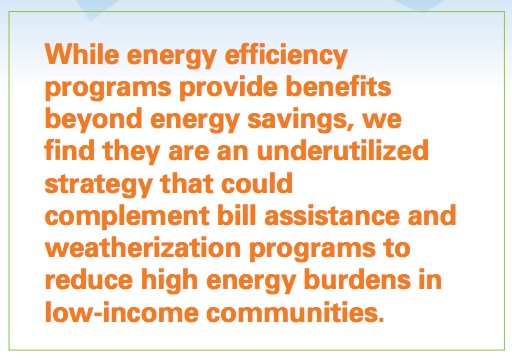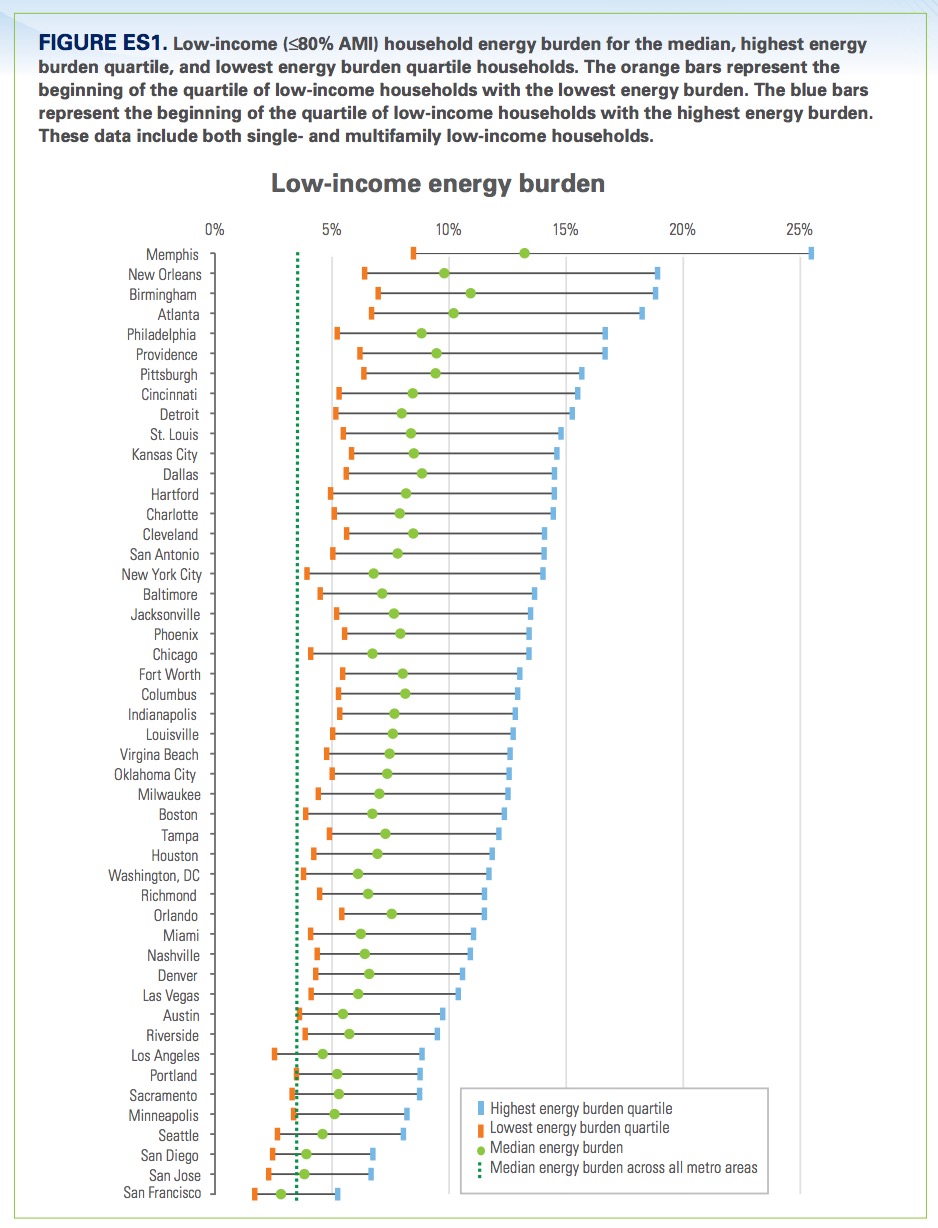AMERICAN COUNCIL FOR AN ENERGY-EFFICIENT ECONOMY (ACEEE)
How Energy Efficiency Can Improve Low Income and Underserved Communities
By Ariel Drehobl and Lauren Ross
Executive Summary
This report provides a snapshot of energy burdens in cities across the US. We focus on the high home energy burdens faced by select groups in major metropolitan areas. Years of analysis by the firm of Fisher Sheehan & Colton determined that low-income households pay proportionally more than the average household for energy costs. Our analysis builds on this research as we take a closer look at energy burden in specific household groups. In the first half of this report, we analyze data from the US Census Bureau’s 2011 and 2013 American Housing Survey to determine energy burden values for 48 of the largest US cities and specific households within each city. In the second half of the report, we discuss strategies for alleviating high energy burdens, with a focus on policies and programs to increase the impact of energy efficiency initiatives in these communities.
Families who face higher energy burdens experience many negative long-term effects on their health and well-being. These families are at greater risk for respiratory diseases and increased stress, and they can experience increased economic hardship and difficulty in moving out of poverty. Our research determined that the overwhelming majority of single-family and multifamily low-income households (those with income at or below 80% of area median income), minority households, low-income households residing in multifamily buildings, and renting households experienced higher energy burdens than the average household in the same city. For example, the median US energy burden across all cities in our sample was 3.5%. The median low-income household’s energy burden was more than twice as high at 7.2%, and three times greater than higher income households (2.3%). Overall, low-income households experienced the highest median energy burden (7.2%), followed by African-American households (5.4%), low-income households living in multifamily buildings (5.0%), Latino households (4.1%), and renting households (4.0%). We also examined the results by region and found that these groups faced the highest average energy burdens in the Southeast and Midwest regions.
 Research Results: US Energy Burden Landscape
Research Results: US Energy Burden Landscape
The efficiency of housing stock is an important factor that influences a household’s energy burden. Low-income households, renters, African-American households, and Latino households paid more for utilities per square foot than the average household, indicating that they reside in less efficient housing (see table ES1).
When we compared each group’s expenditures on energy per square foot with the median household expenditure, we were able to determine the extent to which home inefficiency contributed to energy burden as compared with lower incomes. We found that for low-income households and for multifamily low-income households, bringing housing stock up to the efficiency of the median household would eliminate 35% of excess energy burden, reducing energy burden from 7.2% to 5.9%. For African-American, Latino, and renting households, 42%, 68%, and 97% of their excess energy burdens, respectively, could be eliminated by raising household efficiency to the median.
By examining these specific groups within cities, we found that many households experienced energy burdens that greatly exceeded both the overall median of 3.5% and their city medians. Median energy burdens were as high as 13% for some groups.
For low-income households, we found that energy burden varied substantially. Figure ES1 presents energy burden data for low-income households in each city at the lowest, median, and highest energy burden quartiles. In 17 cities—which is more than one-third of the cities studied—a quarter of low-income households experienced an energy burden greater than 14%, substantially higher than the 3.5% average for all households.
Strategies for Improving Energy Efficiency in Low-Income Communities
Reducing high energy burden on low-income households is a well-established policy objective at the federal, state, and local levels. To help meet this objective, many state utility regulators require that utilities provide bill assistance programs that complement federal programs, such as the Weatherization Assistance Program (WAP) and the Low Income Home Energy Assistance Program (LIHEAP). In addition, many utility regulators require utilities with energy efficiency programs to target low-income customers.
Participants in energy efficiency programs, utilities, and whole communities experience multiple benefits from increased investments in energy efficiency. These benefits include improved health and safety, reduced risk of utility rate increases, reduced costs associated with arrearages and shutoffs, investment in the local economy, and local job creation, among others.5 While energy efficiency programs provide benefits beyond energy savings, we find they are an underutilized strategy that could complement bill assistance and weatherization programs to reduce high energy burdens in low-income communities.
We propose the following strategies for improving energy efficiency in low-income communities: (1) Improve and expand low-income utility programs. (2) Collect, track, and report demographic data on program participation. (3) Strengthen policy levers and leverage existing programs. (4) Utilize the Clean Power Plan to prioritize investment in low-income energy efficiency
Improve and Expand Low-Income Utility Programs
To increase program impact in low-income single and multifamily housing, energy efficiency program managers should design programs to meet the needs of diverse low-income communities, include a range of eligible measures and services, coordinate delivery with other services, align and add on to existing weatherization efforts, address health and safety, and incorporate energy efficiency education into program design.
Low-income programs should also target multifamily customers, who are often underserved by energy efficiency programs. More than two-thirds of the multifamily rental market consists of households that have an annual household income of less than $50,000 (NMHC 2015). Yet residential energy efficiency programs administered by states and utilities have historically focused on single-family, owner-occupied housing. Efficiency measures are far less likely to be installed in multifamily rentals than in any other type of housing, leaving significant energy savings unrealized. Examples of best practices in multifamily programs include integrating direct installation and rebate programs, streamlining rebates and incentives, offering multiple pathways to participation, and incorporating on-bill repayment or low-cost financing, among others.
Access to up-front capital is one of the many barriers to energy efficiency for low-income single- and multifamily households and property owners. Financing programs—provided by several utilities and public and community-based entities—can serve as a complement to energy efficiency programs for low-income customers. With strong consumer protections in place, energy efficiency loans can be beneficial for some households and allow the financing of cost-saving measures. Financing options can also benefit multifamily building owners who lack the up-front capital to invest in energy efficiency retrofits.
Download full version (PDF): Lifting the High Energy Burden in America’s Largest Cities
About the American Council for an Energy-Efficient Economy
aceee.org
The American Council for an Energy-Efficient Economy (ACEEE), a nonprofit, 501(c)(3) organization, acts as a catalyst to advance energy efficiency policies, programs, technologies, investments, and behaviors. We believe that the United States can harness the full potential of energy efficiency to achieve greater economic prosperity, energy security, and environmental protection for all its people.
Tags: ACEEE, American Council for an Energy-Efficient Economy, Ariel Drehobl, Energy Burden, Lauren Ross







 RSS Feed
RSS Feed